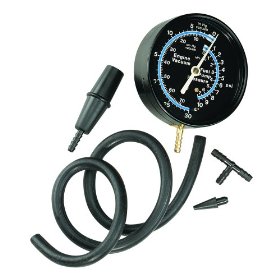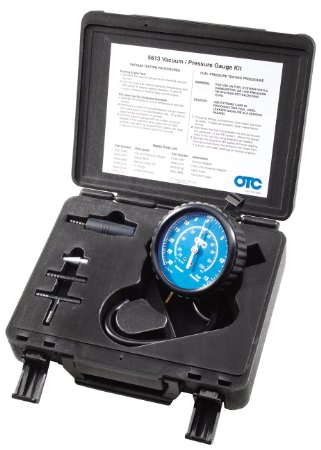Vacuum Gauge Tests
 Here we’ll talk about why the vacuum gauge is my favorite diagnostic tool for engine diagnosis. We’ll also cover how to run some tests and provide a few examples of the tool from popular suppliers like Actron and OTC.
Here we’ll talk about why the vacuum gauge is my favorite diagnostic tool for engine diagnosis. We’ll also cover how to run some tests and provide a few examples of the tool from popular suppliers like Actron and OTC.
This tool is not only inexpensive, but it also provides the quickest route for diagnosis of restricted exhaust systems and leaking exhaust gas recirculation valves.
A leaking EGR emission control valve will cause a low but steady vacuum reading at closed throttle. This is because EGR flow increases manifold pressure and lowers vacuum. The engine is designed to tolerate metered amounts of exhaust gases as the throttle is opened.
However, the efficiency of the cylinders is too low at idle for the engine to accept and digest exhaust gas into the intake charge at closed throttle. Therefore, the egr valve is always closed at idle. Or at least it should be, unless it’s hanging up or not sealing due to carbon deposits on the pintal.
In cases where the valve is stuck wide open, the engine will not start at all. When you have a stuck open EGR valve and the vehicle will not start you will see a vacuum cranking reading of zero. Where as if the valve is closed a cranking vacuum reading should be around three to 5 inches of mercury.
Restricted Exhaust Systems

In order for an engine to operate efficiently it must discharge combustion gases at the same rate it draws in the fresh air and fuel charge. When an exhaust system becomes partially blocked this breathing ability is severely reduced.
Instead of combustion gases exiting through the open exhaust valve the gases back up into the cylinder in search of another way out. The path of least resistance then becomes the open intake valve that allows the high-pressure exhaust gases to back flow into the intake manifold.
Under this condition manifold vacuum drops significantly, to check for a restricted exhaust system connect a vacuum gauge to a convenient source of manifold vacuum. Take a recording with the engine at normal operating temperature and running at around a thousand RPMs.
Next slowly increase the engine speed to 2500 RPMs and note the vacuum reading at that point. If the reading gradually drops more than 3 inches of mercury from the 1000-RPM reading the exhaust system is restricted.
The most likely cause of a restricted exhaust is a clogged catalytic converter. However, don’t overlook the possibility of a collapsed pipe or a damaged muffler stemming from an undercarriage collision. This will also cause low vacuum readings.
Engine Diagnosis
Even though today’s power train control systems or extremely sophisticated. They are not capable of compensating for a worn camshaft lobe, a burned intake or exhaust valve, or a loose or stretched timing chain or belt.
Unfortunately, even though these types of mechanical failures create recognizable symptoms of poor performance or rough engine idle, many mechanics get caught up in analyzing the technical stuff like the data stream without even considering mechanical components or hard parts.
That’s why it is so important to follow a logical diagnostic routine. I have more information about where to hook up your gauge as well as other things that can be diagnosed with a engine vacuum test.

